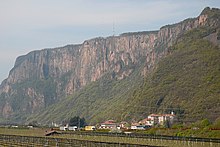Auer formation

The Auer formation ( Italian Formazione di Stiora ), locally and Kastel Ruther porphyry is a powerful up to 600 meters formation in the Südalpen within the Etschtaler Vulkanit group . It mainly consists of pyroclastic current deposits .
The formation is named after the market town of Auer in the South Tyrolean Unterland and was created in the Permian period about 277 to 274 million years ago at the end of a volcanic period lasting about ten million years.
description
The Auer Formation consists mainly of Ignimbrites with a reddish-gray to orange color. These ignimbrites are rhyolites with approximately 1 to 3 mm large crystal intrusions of sanidine , plagioclase and quartz , embedded in a Felsitic flow structure. In the Ignimbrite layers with are lapilli - tuffs or clastic horizons turned on.
The formation is mostly discordant over older formations of the Etschtal volcanic group such as the Andrian Formation or the Gries Formation . But it can also lie directly on the crystalline basement, such as on the Raschötz ridge . The Auer Formation is also discordantly overlaid by the Val Gardena Formation .
Within the formation, a distinction is made between the Perdonig member , whose rocks have fewer and smaller crystals and more flames, which are otherwise rather rare in the Auer Formation. Flame or Italian Fiamme are elongated body made of glass or its conversion products. In addition, gray-black volcanic glasses , so-called Vitrophyrs , appear at the base .
The massive or thick-plate segregated rock is also used for building purposes.
swell
- Autonomous Province of Bozen - South Tyrol: Appiano, geological map sheet 026, scale 1: 25,000 ( scan )
- Rainer Brandner u. a .: Sediment 2007, excursion guide PDF file
- GM Bargossi et al. a .: The Lower Permian Athesian Volcanic Group (AVG) in the Adige valley between Merano and Bolzano: a stratigraphic, petrographic and geochronological outline [1]
